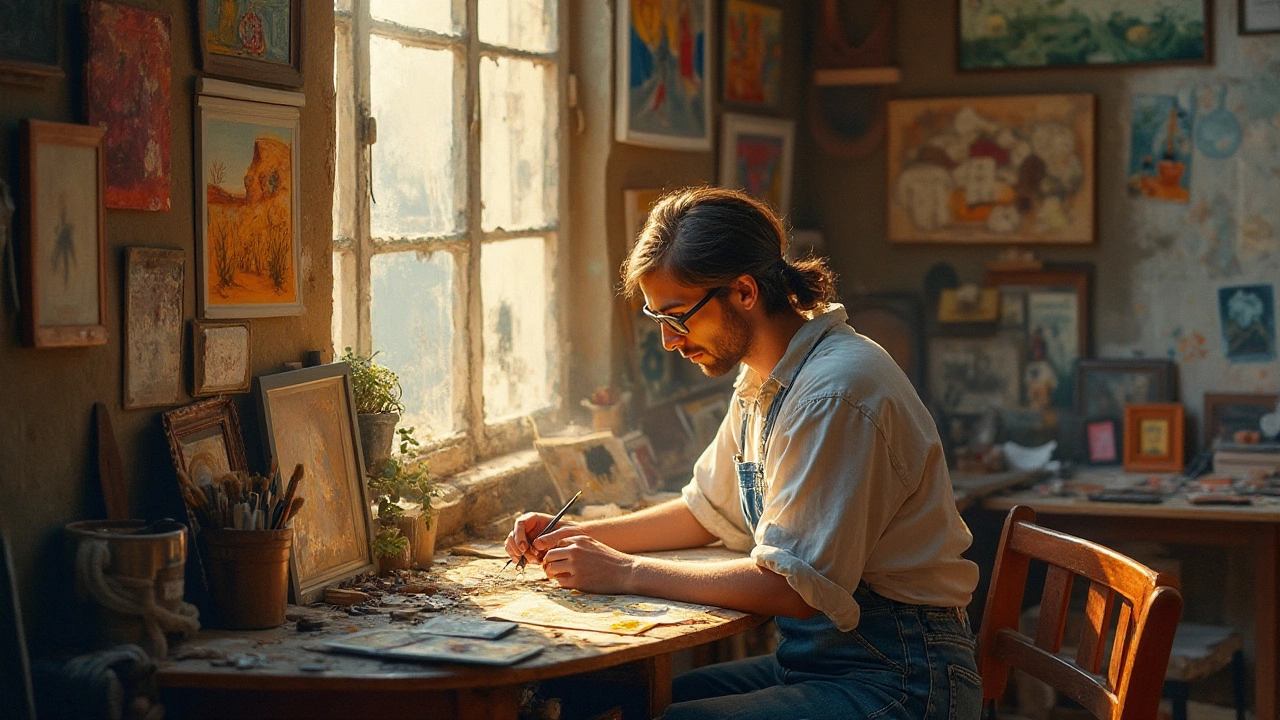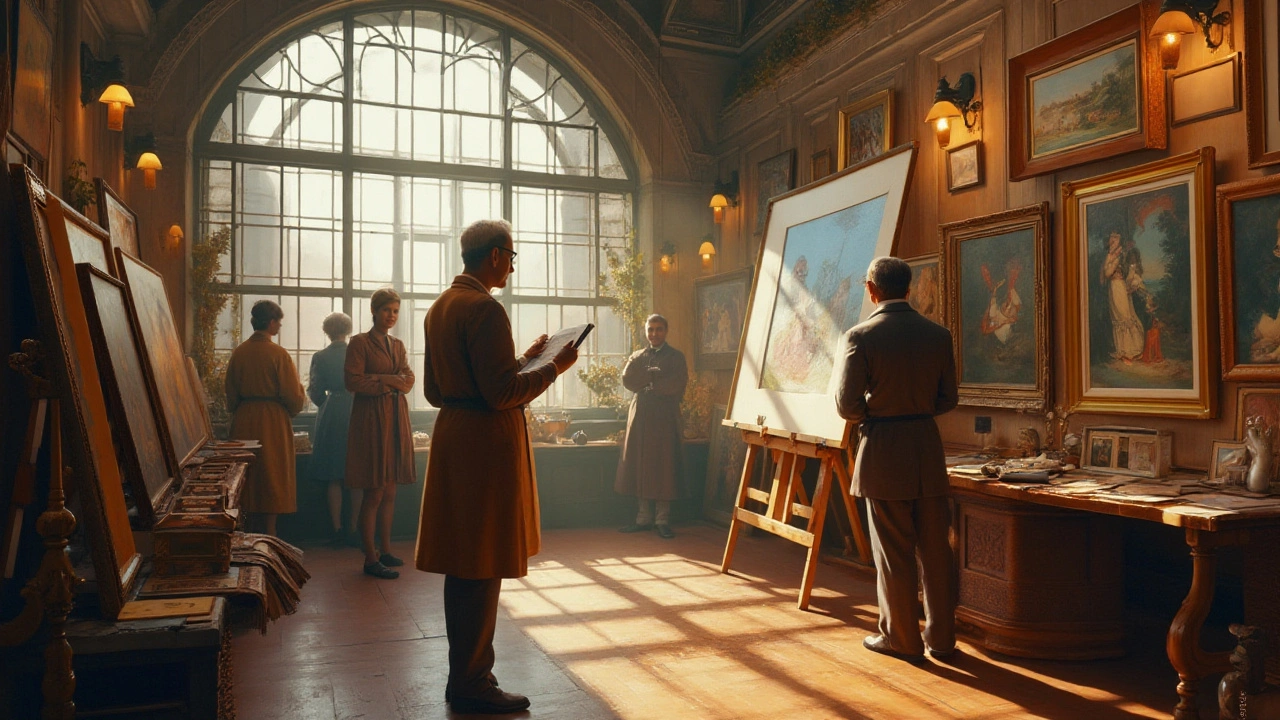Getting your art featured in an exhibition is a dream for many artists. Whether you’re starting or wanting to expand your visibility, the process involves more than just passion. It's a blend of talent, strategy, and good old persistence.
Begin with a robust portfolio—it’s your art's résumé. It should reflect your style and evolution, showcasing both range and depth.
Next, dive into research. Not every gallery aligns with your work, so study them. Visit exhibitions, note their style, and talk to curators if possible.
Your artist statement tells your story; make it personal yet professional. This narrative can resonate with galleries and collectors alike.
When submitting, follow guidelines meticulously. It's your first impression, so make it count. And after submitting, don't disappear. Follow up courteously, showing your genuine interest in being part of an exhibition.
- Building a Strong Portfolio
- Researching and Selecting Galleries
- Crafting Personal Artists Statements
- Submitting and Following Up
Building a Strong Portfolio
Embarking on the journey to create a robust portfolio is a significant step in the artistic realm. A key fact to remember is that this collection of work serves as the first impression you make in the art world. Thus, a substantial amount of effort and thought needs to go into it. The primary goal is to curate a selection that not only highlights your skills and creativity but speaks volumes about your unique perspective and vision as an artist. Consider each piece you include as a voice in your artistic dialogue. Diversity is crucial; include a range of styles, subjects, or techniques to demonstrate your versatility and depth. Avoid stuffing it with every single piece you've ever created; focus instead on quality over quantity. Careful editing—showing only the best—is a strategic decision that reflects your understanding of your audience's perceptions and expectations.
In the digital age, your portfolio can be both physical and digital. Each format has its own set of protocols. A physical portfolio might include high-quality prints and should be presented in a way that respects and enhances the artworks. The digital portfolio, on the other hand, should be easily navigable and optimized for various devices. High-resolution images, while essential, must be balanced with load times to ensure accessibility. Especially in digital presentations, consistency is key. The layout, typography, and overall aesthetic should align with your artistic identity. This creates a seamless experience for the gallery owner or curator skimming through your work.
Testimonials and quotes can provide additional value and context. Including a well-respected artist or critic's opinion on your work can offer credibility.
"A portfolio is a living, breathing entity that evolves with an artist's journey," says renowned art critic Mary D. She advises artists to continuously update their collections to reflect current themes and skills.Such endorsements can illuminate subtleties in your work that might not be immediately perceived, guiding the viewer toward a deeper understanding of your artistic exploration.
As we delve deeper, another aspect of building a strong portfolio is understanding the importance of sequencing. Sequencing refers to the order in which you present your works. It’s like telling a story—one that has an introduction, build-up, climax, and conclusion. This structure can evoke emotions, provoke thoughts, and convey your narrative more effectively. As you lay out your pieces, think of transitions between works. Does one piece lead into another smoothly, or does it jar the viewer's experience?
Lastly, while the art exhibitions themselves require a polished and formal presentation, your portfolio should maintain authenticity. It’s a reflection of you—not just your art. Personalized touches, such as a handwritten thank you note if submitting physically, or personalized email if digital, add an emotional depth that universal templates lack. Keep in mind that many galleries appreciate knowing the person behind the art, how they see the world, and in turn, how they express it through their creations. A portfolio goes beyond just being a collection; it is a tangible extension of you across time and space, capturing the core of what makes your vision truly stand out in the vast sea of artistic expression.
Researching and Selecting Galleries
Finding the right gallery to exhibit your art is akin to finding the perfect stage for a performance. The gallery's style and audience must resonate with your art to create that magical connection. Start by visiting local galleries to understand their vibe. Attend openings and other events. Observe what styles and mediums receive the spotlight. Some artists spend months just understanding the gallery landscape before making a move.
Online platforms are valuable tools for your research journey. Websites like Artsy and Art Rabbit offer insights into gallery reputations and the types of art they prefer. Leveraging these resources can streamline your search process considerably. While doing this, always jot down notes about which galleries might align with your work and why. It’s about finding the perfect fit, not just any fit.
Networking is your secret weapon. Talk to artists who’ve exhibited at venues you’re interested in. They can offer invaluable insights and even introduce you to gallery curators. Building genuine relationships can open doors faster than cold submissions. One artist famously said, "It's not just about having great art; it's about showing it to the right people." This rings true, as often it's the connections you foster that pull your art out of the submission pile.
Consider broader options beyond local galleries. Art fairs and pop-up exhibitions in nearby cities could serve as launching pads for wider exposure. The art scene is vast, and so should be your ambition. Doing detailed research on up-and-coming galleries rather than established ones can also increase chances of acceptance, as emerging venues often seek fresh artists to create buzz.
Art exhibitions rely on submitting work that resonates with the gallery’s identity. Create a list of potential galleries and track your interactions with them. Document which pieces have been shown, submission dates, and feedback received, even if it’s minimal. This practice helps you visualize your journey and decide which art fits best where. A systematic approach makes the daunting task of submitting feel achievable.
Consider creating a gallery checklist with elements like gallery location, size, visitor demographics, and typical artist portfolios they represent. For some, a quirky underground gallery might be the perfect fit, while others may find their place in minimalist, open-space galleries. Match these with your goals. Are you looking for exposure, sales, or critique from top curators? Clarify your priorities. Aim to refine your choices to a handful of venues that align closely with your artistic vision, maximizing your chances of acceptance.

Crafting Personal Artists Statements
Your artist statement is not just a formality; it’s a powerful tool that can connect viewers to your work on a deeper level. Imagine it as a bridge, making the leap from visual to verbal more smoothly for those exploring your creations. The goal is to give insights without overshadowing the art itself. When writing your statement, start by reflecting on your inspiration and motivation, allowing your personality to shine through. Don't shy away from discussing influences or the evolution of your craft, as this exposes your creative journey to the audience. Remember to use a conversational tone—imagine you're having a sincere chat over coffee with someone curious about your art.
An effective statement should be clear, concise, and honest, clocking in at around 150 to 250 words. It should invite the viewer to grasp the essence of your work and your intentions behind it. Break down complex ideas into digestible thoughts, employing simple language that isn’t stuffed with jargon. While creativity is the hallmark of your art, clarity is the backbone of your statement. Take the time to write and revise, as a well-written statement shows professionalism and thoughtfulness. Try to address questions like 'What does my art represent?' or 'What do I want people to see or feel when they look at my pieces?' Keep in mind, this isn’t just about how your art is made, but why it exists.
"A good artist statement is like an engaging story; it should have an introduction, a middle, and a satisfying end, leaving the audience with a sense of understanding," said renowned art critic Jerry Saltz.
You should also consider what might set your work apart in the sea of submissions, as galleries often receive countless applications. Personal anecdotes and distinctive perspectives can make your statement and work memorable. This is your opportunity to convey what’s uniquely personal about your journey, offering the chance for an emotional connection with the reader. Additionally, the practice of writing and refining your statement can often provide new insights and clarify artistic goals that even direct the future path of your creations. In essence, this document is more than a description—it’s a declaration of your artistic identity, a slice of your creative soul shared with the world.
Your audience could range from seasoned art collectors to first-time exhibition visitors. Therefore, adaptability is key; you might tweak your statement to suit the context or audience. While it's crucial to maintain the core of your message, being flexible in your presentation can help resonate more strongly. Some artists take the time to update and reflect on their statement regularly, ensuring it remains relevant as their art evolves. It is also worth noting that collaboration with fellow artists or writers can offer fresh perspectives and enhance your final statement, turning what could be a solitary task into a collaborative effort that fosters creativity and growth.
Submitting and Following Up
When it comes to submitting your work to be featured in art exhibitions, the process requires more than just sending your pieces. Paying attention to the submission guidelines is crucial as galleries often receive numerous entries, and any deviation might lead to disqualification. Start by collecting all necessary materials such as high-resolution images of your work, an updated CV, and your personal artist statements. Ensure the images are well-lit and showcase your art in its best light since this is often the first introduction a gallery has to your work. Many artists make the mistake of overloading their submission with too many pieces, but focusing on quality rather than quantity can make your entry stand out.
Once you've gathered all materials, dedicate some time to review the submission requirements for each specific gallery. While it might be tempting to create a one-size-fits-all package, tailoring your submission to meet each gallery's requirements shows professionalism and a genuine interest in their exhibition. It's important to meet the deadlines and follow the preferred method of submission – whether that be through an online form, email, or even physical delivery. Being organized not only reduces stress but also increases your chances of being noticed. As Picasso once said,
“Action is the foundational key to all success.”
After hitting the 'send' button or mailing your package, the next crucial step is to follow up. This doesn’t mean pestering the gallery but rather waiting for a reasonable time frame before sending a polite inquiry about the status of your submission. The follow-up should be concise and courteous, acknowledging the busy schedules of curators and gallery staff. While patience is indeed a virtue, timely follow-ups display do show enthusiasm and dedication. According to a recent art gallery survey, approximately 45% of successful exhibition submissions included at least one follow-up from the artist, indicating the importance of maintaining communication without being intrusive.
In some cases, especially if you are working with gallery submission platforms, results and feedback arrive faster. Regardless of the outcome, maintain professionalism. If your work is not selected, consider it an opportunity to seek constructive feedback. Many galleries appreciate this initiative, and their insights could prove valuable for future submissions. Should your work be accepted, ensure prompt and efficient communication regarding logistics, such as delivery instructions and exhibition dates. Building a rapport with galleries can lead to repeated invitations and recommendations for other art exhibitions.

